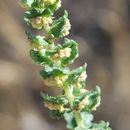Description
provided by eFloras
Annuals, 10–80+ cm. Stems erect. Leaves opposite (proximal) and alternate; petioles 5–15(–25+) mm; blades ± deltate, 15–40(–85+) × 12–35(–80+) mm, 1–2-pinnately lobed, bases cuneate, ultimate margins entire or toothed, abaxial faces hispid and strigillose to sericeous, adaxial faces strigillose and gland-dotted. Pistillate heads clustered, proximal to staminates; florets 1. Staminate heads: peduncles 0.5–2 mm; involucres shallowly cup-shaped (usually each with 1–5+ black nerves), 3–5(–7) mm diam., sparsely hirsute or glabrous; florets 6–12(–20+). Burs: bodies fusiform to obpyramidal, 3–5 mm, ± hirsutulous or glabrate, spines 8–18+, scattered, stoutly subulate (sometimes basally flattened or navicular), 2–4(–5) mm, tips straight or uncinate. 2n = 36.
- license
- cc-by-nc-sa-3.0
- copyright
- Missouri Botanical Garden, 4344 Shaw Boulevard, St. Louis, MO, 63110 USA
Synonym
provided by eFloras
Franseria acanthicarpa (Hooker) Coville
- license
- cc-by-nc-sa-3.0
- copyright
- Missouri Botanical Garden, 4344 Shaw Boulevard, St. Louis, MO, 63110 USA
Comprehensive Description
provided by North American Flora
Franseria montana Nutt. Trans. Am. Phil. Soc. II .7: 345
1840.
An annual herb, or perhaps sometimes perennial; stem 3-6 dm. high, branched, striate and
somewhat strigose; leaves petioled, pinnately parted or lobed, strigose on both sides; blades
ovate in outline, 2-7 cm. long; divisions lobed or toothed, obovate or the terminal one ovate,
the upper confluent; lobes and teeth of the lower leaves usually rounded at the apex; heads
numerous in leafy panicles, the staminate ones racemose, on peduncles 3-4 mm. long; involucre
4-6 mm. broad, sparingly hispidulous, with three dark ribs running into the three upper lobes,
sometimes with an additional but fainter one in the innermost lobe; lobes rounded, ovate; corolla
glabrous; pistillate heads in clusters in the upper axils, 1-flowered; fruit about 8 mm. long,
slightly glandular-puberulent: beak subulate, 3 mm. long; spines 15-30, in about 4 series,
flattened, channeled, lanceolate or linear-lanceolate or rarely rudimentary in some of the
heads.
Type locality: Rocky Mountains, near the Colorado of the West. Distribution: Oregon to Wyoming, Utah, and California.
- bibliographic citation
- Per Axel, Rydberg. 1922. CARDUALES; AMBROSIACEAE, CARDUACEAE. North American flora. vol 33(1). New York Botanical Garden, New York, NY
Comprehensive Description
provided by North American Flora
Franseria acanthicarpa (Hook.) Coville, Contr. U. S. Nat Herb. 4: 129. 1893.
Ambrosia acanthicarpa Hook. Fl. Bor. Am. 1: 309. 1833. Franseria Hookeriana Nutt. Trans. Am. Phil. Soc. II. 7: 345. 1840. Gaertneria Hookeriana Kuntze, Rev. Gen. 339. 1891. Gaertneria acanthicarpa Britton, Mem. Torrey Club 5: 332. 1894.
An annual herb, or perhaps sometimes perennial; stem 3-6 dm. high, branched, striate, strigose as well as more or less hirsute, with scattered white hairs with pustulate bases; leaves petioled, bipinnatifid almost to the midrib, strigose on both sides and somewhat hirsute on the veins; blades ovate in outline, 5-10 cm. long; divisions linear to oblong, from rounded to acute at the apex; heads numerous in leafy panicles, the staminate ones racemose, on peduncles 3-4 mm. long; involucre 2.5-4 mm. broad, sparingly hispidulous or glabrate, dark olive-green, with 3 dark ribs in the upper lobes; lobes ovate, rounded at the apex; corolla glabrous; pistillate heads in small clusters in the upper axils, 1-flowered; fruit 8-10 mm. long, ellipsoid, sparingly hirsute or glabrate, slightly glandular-granuliferous, reticulate-ridged; beak solitary, subulate; spines flattened, 8-20, in 3-4 series, lanceolate, connected with ridges, about 4 mm. long.
The northern form is more hispid than the southern, and with larger, permanently hairy
fruit.
Type Loality: Banks of the Saskatchewan.
Distribution: Sandy soil, Saskatchewan and Alberta to Missouri, Texas, and southern California.
- bibliographic citation
- Per Axel, Rydberg. 1922. CARDUALES; AMBROSIACEAE, CARDUACEAE. North American flora. vol 33(1). New York Botanical Garden, New York, NY
Ambrosia acanthicarpa: Brief Summary
provided by wikipedia EN
Ambrosia acanthicarpa is a North American species of bristly annual plants in the family Asteraceae. Members of the genus Ambrosia are called ragweeds. The species has common names including flatspine bur ragweed, Hooker's bur-ragweed, annual burrweed, annual bur-sage, and western sand-bur. The plant is common across much of the western United States and in the Prairie Provinces of Canada.
This spiny, weedy plant grows in clumps of many erect stems which may reach over a meter in height. Its gray-green stems are covered in a coat of stiff, bristly hairs. The few rough leaves are several centimeters long. The racemes of flowers are more plentiful, with each hairy flower head a few millimeters wide. The spiny, burr-like pistillate heads have pointed, twisting bracts and the staminate heads are rounded. The species is adaptable and grows well in disturbed areas, easily becoming weedy.
- license
- cc-by-sa-3.0
- copyright
- Wikipedia authors and editors

